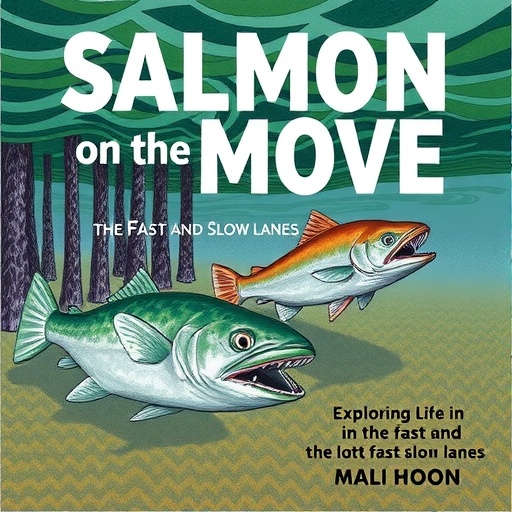In a groundbreaking study emerging from Kyoto University, researchers have unlocked new insights into the complex life-history variation of masu salmon (Oncorhynchus masou) across heterogeneous river landscapes. This seminal work offers unprecedented understanding of how salmon populations sustain their diversity and adapt to environmental changes over both spatial and temporal scales. The study meticulously maps the intricate balance between fast and slow life-history strategies within and between distinct river habitats, shedding light on evolutionary processes that underpin population resilience in the face of climate change.
Life-history variation—the differences in timing and strategies organisms adopt to grow, reproduce, and survive—is a cornerstone of ecological adaptation that enables species to thrive in fluctuating environments. Despite the well-documented differences in life histories across varied habitats, there has been a notable gap in understanding the extent and structure of this variation within singular habitats along connected river systems. Kyoto University’s team, led by Takeya Shida, sought to address this lacuna by investigating how seasonal growth opportunities and maturation decision-windows interact across different river segments to influence salmon life-history traits.
Masu salmon, a species widely distributed in temperate watersheds, exhibit two prominent life-history trajectories: fast-life and slow-life strategies. In the fast-life strategy, juveniles experience accelerated early growth, initiating gonadal development in spring and maturing by autumn of the same year. Conversely, slow-life individuals defer maturation for an additional year, presumably balancing growth and survival risks. This dichotomy serves as an ideal model to explore how environmental heterogeneity modulates life-history variation within a connected waterscape.
The team’s study took place along a large temperate watershed in Japan, where six distinct river reaches were selected to represent varying thermal regimes and prey availability. Through continuous monitoring of water temperatures, aquatic and terrestrial prey abundance, combined with detailed measurements of juvenile salmon growth rates and mature fish age structures, the researchers developed a comprehensive hierarchical model to quantify life-history variation. This allowed them to evaluate not only differences between habitats but also the considerable variation maintained within individual habitats.
Findings from the study revealed a striking spatial pattern: downstream river reaches with warmer temperatures and richer aquatic invertebrate communities predominantly supported fast-life salmon populations. These environments facilitate rapid growth early in the season, granting fish the energetic capacity to mature within the same year. In contrast, upstream habitats characterized by cooler temperatures, sparse aquatic prey, but a unique influx of terrestrial invertebrates favored slow-life individuals who postponed maturation, possibly as an adaptive response to constrained growth conditions.
Importantly, despite clear differences between upstream and downstream habitats, the authors detected substantial life-history diversity within most river reaches. Variability in maturation age was not exclusively structured by habitat boundaries, but rather was heavily influenced by fine-scale environmental and ecological factors within habitats. Notably, the availability of terrestrial prey from riparian forests emerged as a significant determinant of within-habitat variation, challenging traditional paradigms that focus solely on aquatic productivity.
These nuanced observations implicate terrestrial-aquatic linkages as critical influences shaping salmon life histories. Riparian zones, often overlooked in fish ecology, appear to subsidize food webs in upstream reaches, enabling slow-life strategies and sustaining life-history diversity. This dynamic is particularly salient in the context of habitat homogenization driven by anthropogenic landscape alterations, which threaten the ecological complexity vital for maintaining such intra-population diversity.
Shida and colleagues underscore the urgent necessity for conservation and management frameworks that prioritize the preservation of life-history diversity within salmonid populations. As climate change accelerates shifts in thermal regimes and stream productivity, maintaining both fast- and slow-life pathways within waterscapes could buffer populations against environmental uncertainties, enhancing their evolutionary potential and long-term viability.
This study also highlights the imperative for ecosystem-based resource management, recognizing the integrated role of terrestrial and aquatic habitats in governing population dynamics. Protecting riparian forest integrity and ensuring habitat heterogeneity could be pivotal strategies for facilitating adaptive responses in salmon populations confronted by global climate perturbations.
In a broader scientific context, this research contributes to our understanding of hierarchical ecological variation—a concept reflecting that population traits are governed by multi-scale processes, from microhabitat conditions to entire watershed characteristics. The elegant quantification of life-history variation within and among habitats as demonstrated here serves as a model for investigating evolutionary ecology in other species facing environmental change.
Moreover, the integration of long-term seasonal growth data with maturation decision-making models underscores the importance of temporal windows during which organisms commit to life-history strategies. This “maturation decision-window” concept reframes how ecologists consider phenological timing within life cycles, especially for organisms inhabiting dynamic and heterogeneous landscapes.
As the study propels forward, future research avenues could explore genetic underpinnings of the observed life-history variation and the potential for plasticity in maturation strategies in response to rapidly changing climates. Linking genomic data with these ecological patterns could unravel the molecular mechanisms facilitating adaptive diversification in salmonids.
Ultimately, the comprehensive investigation by Kyoto University researchers into the hierarchical organization of life-history variation in masu salmon provides a pivotal reference point in evolutionary ecology. It calls attention to the delicate yet resilient interplay of environmental variability, ecological interactions, and life-history strategies that sustain biodiversity in freshwater systems globally.
Subject of Research: Animals
Article Title: Hierarchical organization of life-history variation in a salmonid fish across riverscape: relevance of seasonal growth opportunity and maturation decision-window
News Publication Date: 21-Oct-2025
Web References: http://dx.doi.org/10.1111/1365-2656.70141
References: Kyoto University, Journal of Animal Ecology
Image Credits: KyotoU / Takeya Shida
Keywords: Fish, Aquatic ecology, Ecology, Animal ecology, Climate change adaptation, Climate change




